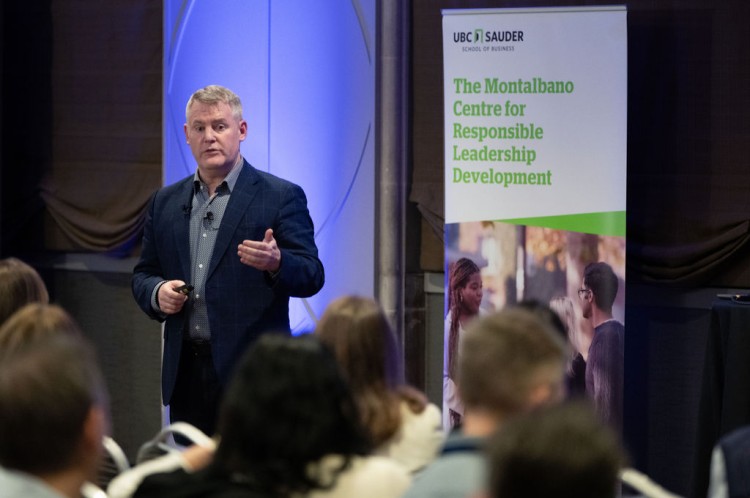
Future in focus: How leaders can drive innovation by asking "why?" - by Darren Dahl, Dean at UBC Sauder

Curiosity is often thought of as a trait of the young—a child’s impulse to ask “why” a hundred times in a row or an early-career professional eager to learn. But the reality is that the most effective leaders never stop asking questions.
When I took the stage to kick off the first session of UBC Sauder’s Future in Focus series, I wanted to challenge the way we think about leadership and innovation. Curiosity, I believe, is the key to unlocking real progress. The event, hosted by UBC Sauder Executive Education and Continuing Business Studies and supported by the Montalbano Centre for Responsible Leadership Development, brought together industry leaders and alumni to explore how curiosity can drive organizational success.

Why we lose curiosity—and why it matters
As professionals advance in their careers, they tend to rely on heuristics—mental shortcuts that help them navigate their work efficiently. These routines, while easy to fall into, can also dull curiosity.
I recall a personal experience from a project where creative energy seemed stagnant. We were in a room full of experienced business professionals, and yet there was no spark in the room. That’s when I realized: curiosity wasn’t in the equation. We asked ourselves, “why does it have to be this way?” Surrounding yourself with people who challenge your thinking can be a game-changer. I actively seek out people who will argue with me. It’s in those disagreements that new ideas are born.
Curiosity is not the exclusive domain of youth. Many of the world’s greatest innovators pivoted careers or discovered new passions later in life. Astronauts, musicians, and entrepreneurs alike have shown that curiosity—not age—determines who remains at the forefront of change.
The power of unconventional thinking
Throughout history, those who have shaped industries and ideas have often been the ones willing to explore beyond the obvious. Consider Brian May, lead guitarist of the rock band Queen, who went back to school to pursue his PhD in astrophysics despite a successful musical career that continues to inspire generations. Innovation happens when people connect ideas across disciplines—a process driven by curiosity.
Research from the Harvard Business Review supports this, showing that highly curious individuals tend to be more adaptable, creative and successful in leadership roles. They are better at managing uncertainty, solving complex problems and inspiring teams to think differently.
How leaders can cultivate curiosity in their organizations
So how can leaders actively foster curiosity in their teams and within themselves? Here are my five key tips:
-
1. Ditch the excuses
A common barrier to curiosity is time—or the perceived lack of it. Leaders often feel too busy to explore beyond their immediate responsibilities. But curiosity doesn’t require a major overhaul; it can be as simple as dedicating ten minutes a day to exploring an unfamiliar topic.
When I was doing my PhD at UBC, I followed a professor who, once a week, would pick a random book from the library stacks—on a subject completely unrelated to his field. It was a simple exercise, but it broadened his thinking. -
2. Keep asking why
Great leaders don’t just look for answers, they ask better questions. The key is to dig deeper and challenge assumptions. I remember walking out of a Hermès store, having purchased two bottles of cologne despite a seemingly judgmental customer service experience. My idle curiosity about the effect of this experience on my impressions of the brand led to a research project on the emotional triggers behind luxury marketing. Simply wondering why something is the way it is can open doors to entirely new areas of understanding. -
3. Break routine and be comfortable with discomfort
Innovation often comes from changing environments and perspectives. One researcher I work with always enjoys meeting in new and unconventional locations. From mall food courts to hotel lobbies, you name it. Likewise, putting yourself in intellectually uncomfortable discussions allows you to explore new perspectives and challenge your own, leading to unexpected breakthroughs. -
4. Experiment often and embrace failure
In science, failure isn’t seen as a dead end, but rather a stepping stone. Leaders should adopt this mindset, encouraging their teams to experiment without fear of failure. Richard Feynman, one of the greatest physicists of all time, put it best: “I’m always looking, like a child, for the wonders I know I’m going to find.” By framing failures as learning opportunities, organizations create space for discovery. -
5. Observe the outliers
Some of the greatest innovations come from people who don’t fit the mold. I remember observing an entrepreneur at CDL Vancouver who had what I thought was a great startup idea but struggled with moving the room towards it – he had a unique, but unsuccessful pitch approach. Why didn’t he see success? To answer this outlier question we analyzed all CDL pitches over time to define patterns in soft signals that result in entrepreneurial success and failure.
Look for people who are a bit different and walk a different path. We learn from these individuals and can identify unique opportunities their behaviors can present. Indeed, look for people who think differently and pay attention to the problems that frustrate them. That’s often where the best innovations begin.
Making curiosity a leadership priority
If innovation is the engine of progress, then curiosity is the fuel. The most effective leaders don’t just passively accept what they know; they actively seek out what they don’t. Surround yourself with people who challenge your thinking.
Are you managing your people to be curious? Whether by asking better questions, breaking routines, or learning from outliers, curiosity is a skill that can be cultivated—and those who embrace it will be the ones shaping the future.
As we continue our Future in Focus speaker series and if you choose to take one of our professional development programs, I challenge you to look through this lens of curiosity. You may be surprised by how it can shift the way you innovate.
So, what’s your next question?